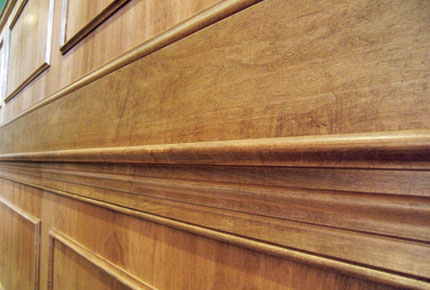 Controlling raw material costs is a constant concern in any woodworking shop. By optimizing yield in the rough mill area, particularly at the moulding operation, wood products manufacturers can master the situation.
Controlling raw material costs is a constant concern in any woodworking shop. By optimizing yield in the rough mill area, particularly at the moulding operation, wood products manufacturers can master the situation.
The optimization process begins several stages before the material reaches the moulder, in the ripping operation.
“The greatest opportunity for controlling material costs and maximizing yield happens during the ripping process to prepare blanks for the moulder,” said Tim Brown, marketing manager at Mereen-Johnson. “Using a precision gang rip saw delivering straight and accurate rips can reduce the amount of moulder material removal allowance required. Utilizing a rip optimizing system, a shifting blade gang rip saw, or pre-sorting boards to be processed on a fixed arbor gang rip saw are all means to optimize raw materials.”
Creating well-prepared blanks is essential to the process, agreed Chuck Carter, Kentwood product manager at Stiles Machinery. “The secret to preparing better moulder blanks is to measure and consider the boards dimensional data more precisely. The better the dimensional data resolution, the better the solution the optimizer can provide,“ he said.
The advent of 3D sensors on some of the newer ripping machines gives operators the ability to measure the board’s entire shape, while either moving or static, making “detection automatic and effortless without sacrificing capacity performance,” Carter added.
“Today, these systems will allow the operator to utilize both grade and rip optimization for the best yield and value performance. When the blanks of the best quality and rip value are received at the moulder for processing, yield is ensured to remain high regardless of long or short runs,” he said.
Once quality blanks are readied for the moulder, “There are a few small things that can be done as far as optimizing yields during the moulding process,” said Steven McNeilly, product manager at Michael Weinig Inc.
“Operators can be trained to feed material into the machine in the correct orientation. One can also make sure knives are sharp and pressure elements are set correctly, which will produce a better finish with less unusable finished product. Measuring tools properly can also help by improving moulder setup, thus requiring the use of fewer setup pieces,” he said.
“Better organization can also lead to better choices and fewer mistakes. For example, moulding the wrong material with the wrong profile is a costly, yet common mistake. Simple systems can be deployed in the moulding process to eliminate these types of waste,” McNeilly added.
The new features and capabilities available with today’s moulders ensure their role as a workhorse in the woodworking plant, both for production and custom runs.
Features Add to Flexibility
“The main developments and features of moulders today have to do with the controllers, tool locking features and affordability,” said Tim Sermonet, sales manager at SCM Group North America, Advanced Machinery Division.
“Customers at all levels are looking for quicker setup times, more user friendly machines and machines that smaller shops can afford. Touchscreen controllers that adjust the positioning of the spindles both vertically and horizontally, store programs, have bar coding capabilities, monitor production information and maintenance schedules, and perform diagnostic functions are all features that customers are looking for in today’s moulders,” he added.
Reducing setup time was also noted by McNeilly, “The latest development and improvements on moulders are geared toward reducing moulder setup/downtime. When a moulder is not running wood it isn’t making money, and with moulding orders getting smaller and more custom, the amount of time spent setting up a machine in a given shift is naturally going to increase.”
Quicker and easier tool changes on the machines are also a must, noted Sermonet, McNeilly and Carter. A number of equipment manufacturers offer rapid tool locking devices that enable the moulder operators to change the heads in seconds.
“The demand for this type of technology is not limited to just the larger companies,” Sermonet said. “Small to medium shops demand the same features at a reasonable price. “
Another development noted by Carter to ease tool changes is through the use of mechanical spindle nuts, where “the conventional spindle wrench is completely eliminated. The operator only needs a T-handled Allen wrench to secure the tool to the shaft. The mechanical design provides 2.5 times the locking force of the larger wrench,” he said.
Other developments, including: CNC positioning of spindles, computer set pressure elements, and machine integration can dramatically increase moulder efficiency and improve flexibility, McNeilly and others noted.
“These features can inherently solve another major problem faced by moulding manufacturers — labor. While there is still the need for an operator to load/unload material at the machine, these same features allow a less skilled operator to run the machine. This can reduce manufacturing cost through lower labor rates and keep the company from being at the mercy of their labor force,” McNeilly said.
Carter also commented on moulder advancements being made in the top horizontal spindle’s pressure pad shoe design. “In the past, dovetail designs were standard. However, this metal-to-metal friction would allow the pad shoe to stick unless well lubricated and maintained. If the pad shoe is not free floating, then trailing edge defects and other chatter type defects would result.
“The bearing system allows super free floating ability with no sticking,” Carter said. “It is really a benefit when machining very small mouldings that typically stop under sticky dovetail type pad shoes. The new free-floating bearing design movement of these pad shoes have allowed end defects to be a thing of the past.
“These wish list items are reality today,” he added.
Click here to view tips and some frequently asked questions by woodworkers.






Have something to say? Share your thoughts with us in the comments below.